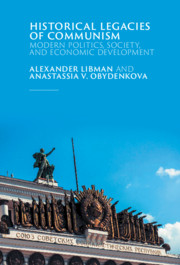Book contents
- Historical Legacies of Communism
- Historical Legacies of Communism
- Copyright page
- Dedication
- Contents
- Figures
- Maps
- Tables
- Acknowledgments
- Abbreviations
- 1 Introduction
- 2 The CPSU Legacy: Leninism or Clientelism?
- 3 Cultural Environment and Soviet Cinematography as a Legacy of the CPSU
- 4 Measuring CPSU Legacies
- 5 Democracy
- 6 Corruption
- 7 Inequality
- 8 Mortality
- 9 Attitudes Toward Migrants
- 10 Economic Development and Innovations
- 11 The Origin and Persistence of Legacies
- 12 Conclusion
- Bibliography
- Index
3 - Cultural Environment and Soviet Cinematography as a Legacy of the CPSU
Published online by Cambridge University Press: 27 January 2021
- Historical Legacies of Communism
- Historical Legacies of Communism
- Copyright page
- Dedication
- Contents
- Figures
- Maps
- Tables
- Acknowledgments
- Abbreviations
- 1 Introduction
- 2 The CPSU Legacy: Leninism or Clientelism?
- 3 Cultural Environment and Soviet Cinematography as a Legacy of the CPSU
- 4 Measuring CPSU Legacies
- 5 Democracy
- 6 Corruption
- 7 Inequality
- 8 Mortality
- 9 Attitudes Toward Migrants
- 10 Economic Development and Innovations
- 11 The Origin and Persistence of Legacies
- 12 Conclusion
- Bibliography
- Index
Summary
This chapter looks at the cultural environment in which the CPSU legacy flourishes. Specifically, it focuses on Soviet movies and their perception by Russian society. It shows that Soviet cinematography still enjoys very high popularity in Russia (to a larger extent than modern Russian movies or even foreign movies) and describes how Soviet movies (directly or indirectly) create a favorable environment for the persistence of the legacies of the Communist past. It also briefly looks at how the Communist era is discussed in modern Russian cinema and how it reuses the concepts and ideas of Soviet cinematography.
- Type
- Chapter
- Information
- Historical Legacies of CommunismModern Politics, Society, and Economic Development, pp. 52 - 81Publisher: Cambridge University PressPrint publication year: 2021

